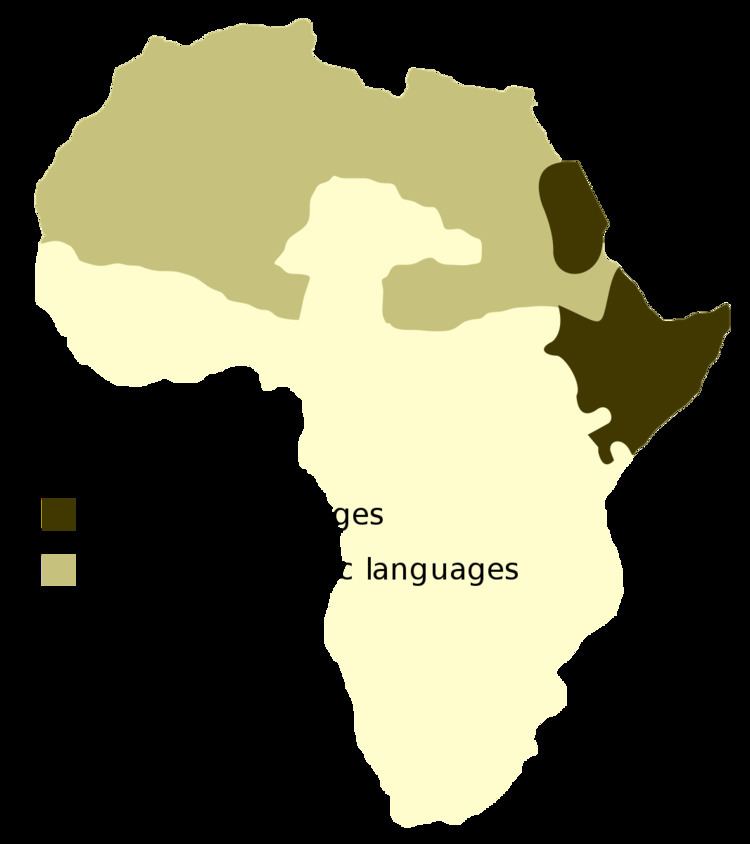Geographicdistribution: Northeast Africa Proto-language: Proto-Cushitic Glottolog: cush1243 | Linguistic classification: Afro-AsiaticCushitic ISO 639-2 / 5: cus | |
 | ||
Subdivisions: ? Beja ("North")Agaw languages ("Central")? DullayHighland East Cushitic ("Sidamic")Lowland East Cushitic? South Cushitic | ||
The Cushitic languages are a branch of the Afroasiatic language family. They are spoken primarily in the Horn of Africa (Somalia, Eritrea, Djibouti, and Ethiopia), as well as the Nile Valley (Sudan and Egypt), and parts of the African Great Lakes region (Tanzania and Kenya).
Contents
The most widely spoken Cushitic language is Oromo (including all its variations) with about 35 million speakers, followed by Somali with about 18 million speakers, and Sidamo with about three million speakers. Other Cushitic languages with more than one million speakers are Afar (1.5 million) and Beja (1.2 million). Somali, one of the official languages of Somalia, is the only Cushitic language accorded official status in any country. Along with Afar, it is also one of the recognized national languages of Djibouti.
The phylum was first designated as Cushitic around 1858. The languages spoken in the ancient Kerma Culture (present-day southern Egypt and northern Sudan) and in the Savanna Pastoral Neolithic in the Great Lakes region are thought to have belonged to the Cushitic branch of Afroasiatic.
Composition
The Cushitic languages are usually considered to include the following branches:
Lowland and Highland East Cushitic are commonly combined with Dullay into a single branch called East Cushitic.
Divergent languages
Beja, or North Cushitic, is sometimes listed as a separate branch of Afroasiatic. However, it is more often included within the Cushitic branch.
There are also a few poorly-classified languages, including Yaaku, Dahalo, Aasax, Kw'adza, Boon, the Cushitic element of Mbugu (Ma’a) and Ongota. There is a wide range of opinions as to how the languages are interrelated.
The positions of the Dullay languages and of Yaaku are uncertain. They have traditionally been assigned to an East Cushitic branch along with Highland (Sidamic) and Lowland East Cushitic. However, Hayward thinks that East Cushitic may not be a valid node and that its constituents should be considered separately when attempting to work out the internal relationships of Cushitic.
The Afroasiatic identity of Ongota is also broadly questioned, as is its position within Afroasiatic among those who accept it, because of the "mixed" appearance of the language and a paucity of research and data. Harold C. Fleming (2006) proposes that Ongota is a separate branch of Afroasiatic. Bonny Sands (2009) thinks the most convincing proposal is by Savà and Tosco (2003), namely that Ongota is an East Cushitic language with a Nilo-Saharan substratum. In other words, it would appear that the Ongota people once spoke a Nilo-Saharan language but then shifted to speaking a Cushitic language while retaining some characteristics of their earlier Nilo-Saharan language.
Hetzron (1980:70ff) and Ehret (1995) have suggested that the South Cushitic languages ("Rift") are a part of Lowland East Cushitic, the only one of the six groups with much internal diversity.
Cushitic was traditionally seen as also including the Omotic languages, then called West Cushitic. However, this view has largely been abandoned, with Omotic generally agreed to be an independent branch of Afroasiatic, primarily due to the work of Harold C. Fleming (1974) and M. Lionel Bender (1975).
Extinct languages
A number of extinct populations are thought to have spoken Afro-Asiatic languages of the Cushitic branch. According to Peter Behrens (1981) and Marianne Bechaus-Gerst (2000), linguistic evidence indicates that the peoples of the Kerma Culture in present-day southern Egypt and northern Sudan spoke Cushitic languages. The Nilo-Saharan Nobiin language today contains a number of key pastoralism related loanwords that are of proto-Highland East Cushitic origin, including the terms for sheep/goatskin, hen/cock, livestock enclosure, butter and milk. This in turn suggests that the Kerma population — which, along with the C-Group culture, inhabited the Nile Valley immediately before the arrival of the first Nubian speakers — spoke Afro-Asiatic languages.
Additionally, historiolinguistics indicate that the makers of the Savanna Pastoral Neolithic (Stone Bowl Culture) in the Great Lakes area likely spoke South Cushitic languages. Christopher Ehret (1998) proposes that among these idioms were the now extinct Tale and Bisha languages, which were identified on the basis of loanwords.
